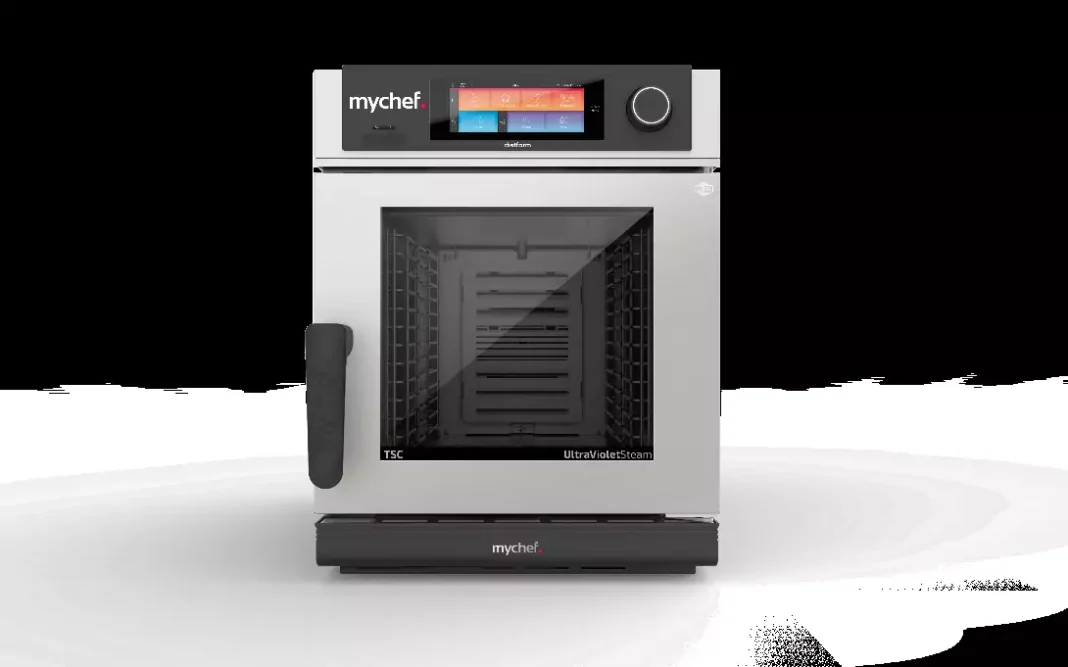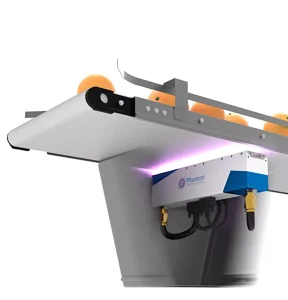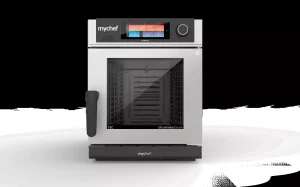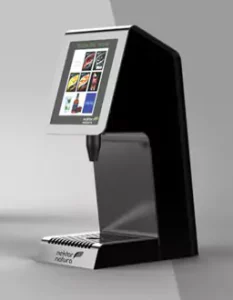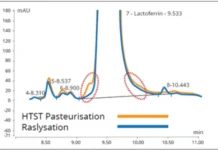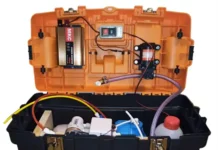Molly McManus
regional sales manager, AquiSense Technologies
Kayla Doerzbacher
applications engineer, AquiSense Technologies
The first step to appreciating food safety is understanding the magnitude of the problem. Foodborne illness has a much larger reach than many people realize. Besides the obvious threat to human safety, food safety also impacts the environment and the global economy.
Human health
Assigning numbers to the human health aspect of food safety is sobering, to say the least. According to the Centers for Disease Control and Prevention (CDC), 48 million people suffer from food poisoning every year in the US1. Expanding out to a global scale, the World Health Organization (WHO) estimates there are 600 million cases of foodborne illness every year2, and 420,000 of those cases result in death – 30% of the victims are younger than 52.
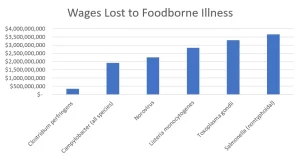
Most foodborne illnesses are diarrheal types, specifically norovirus and campylobacter2. Norovirus, specifically, is common on leafy greens, fresh fruit and some types of seafood3.
Environmental impact
The next level of food safety is protecting the environment where food is grown. Employing better food safety practices not only protects human health but decreases the amount of food wasted every year. Nearly one-third of all global food goes to waste every year4, yet 69% of all fresh water goes to agriculture5. Water scarcity, defined as the demand for fresh water outweighing the fresh water resource, affects 1.2 billion people worldwide, or about 20% of the population6. Technically, there is enough fresh water to meet the world’s demands, but much of it is polluted, mismanaged or wasted6.
For example, the discharge of used water – whether municipal or industrial – could be a large part of the water scarcity solution. Countries considered to be wealthy treat only 70% of their used water, while low-income countries treat less than 10%7. According to the United Nations, an estimated 80% of all used water is not treated before it is discharged to the environment7.
This massive amount of unusable discharge puts additional pressure on water resources by polluting clean water sources. Consider the tragedy of Minamata City, Japan. In 1956, convulsing children were being rushed to hospitals while their ability to walk and speak simultaneously deteriorated8. Doctors were baffled and paired with a university research group in hopes of finding the cause of what became known as Minamata Disease. Heavy metal poisoning eventually was found to be the culprit, and the source was easily identified as industrial discharge from the Chisso Corporation chemical factory8. To this day, Chisso has paid more than $86 million in restitution and worked to clean the city8.
Minamata is a unique example due not only to the obvious severity of the problem, but because the responsible parties were held accountable and worked to restore their community. There are hundreds of cities like Minamata in lower-income countries that continue to operate unchecked.
Economic stability
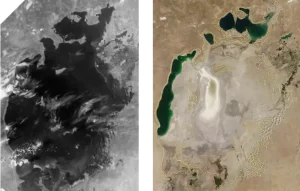
A less obvious effect of poor food safety is economic stability. According to a United States Department of Agriculture study, foodborne illnesses cost the US economy $15.6 billion every year in lost wages9. The top five illnesses are shown in the chart on page 29. Please note the chart does not represent the true cost of illness, as it does not account for healthcare costs, medication, company losses, etc.

Exacerbated water scarcity has led to the full collapse of once thriving areas. The Aral Sea, shown in 1964 and 2018, once supported a vast fishing industry in Kazakhstan and Uzbekistan. Starting in 1991, the Soviet Union rerouted the Amu Darya River for irrigation and essentially cut off the water supply to the Aral Sea10. Once the fourth largest lake in the world, 80% of the sea had evaporated by 2005, and 60,000 fishing jobs had left the region10. Residents have all but abandoned the area, so now only ship graveyards remain as a testament to what was.
Role of UV technology in food safety
There are more than 250 known foodborne illnesses1. Of these, none of them is 100% resistant to UV-C disinfection but they require differing UV doses. UV-C disinfection is currently utilized in a variety of food surface applications: surfaces, brines, sugar syrups, alternatives to pasteurization in milk processing and water processing.
While a great technology, traditional, gas-discharge UV disinfection technology isn’t without limitations. Traditional systems require a lengthy warm-up time before they can disinfect properly. This not only delays the treatment process but requires the system to consume energy prior to treatment. Conversely, a UV-C LED system has a nearly instantaneous start-up, so treatment is faster and more energy efficient.
Being a solid-state technology, LEDs are more robust than their gas-discharge counterparts and can withstand multiple power cycles without their aging being accelerated. Traditional technologies can only handle about five power cycles a day before their lifetime starts to deteriorate. This, combined with a long warm-up time, eliminates the option of using traditional systems for intermittent applications while LED systems are perfectly suited for them.
Traditional systems also heat liquid as they treat it, while LED technology has decoupled light and heat so light shines from the front of an LED while heat exits through the back of the LED. This simple change significantly reduces the time and cost associated with maintaining a UV system, as fouling is significantly reduced when heat is removed.
UV-C LED systems also are immune to fluid temperature. Traditional systems do not operate properly if the fluid is too hot or too cold, while LEDs give optimal performance regardless of temperature. This, combined with LEDs not heating fluid during treatment, enables UV disinfection to be used in applications where heat is not wanted – such as frozen food applications.
Current state of UV-C LED technology
UV-C LED technology has been rapidly improving over the last 20 years. Graph 2 on page 31 shows how the output of commercially available UV-C LEDs has steadily increased over the last two decades. The number of UV-C LED manufacturers also has increased.
UV-C LED technology also is following Haitz’s Law, so the price per mW is decreasing while the output is increasing. Graph 3 illustrates the falling prices.
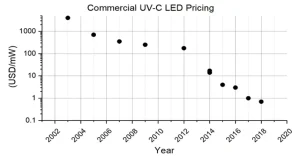
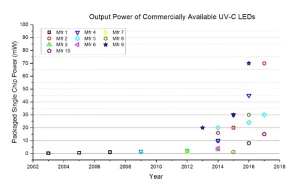
Case studies
The combination of increased output with decreasing prices allows UV-C LED systems to be used in a variety of applications. The following four processes currently utilize UV-C LED solutions.
Problem: Pathogens on conveyor belt can spread quickly to all fruit being processed.
Goals: Disinfect belt while in use.
Key Design Parameters: System must be mounted under the conveyor belt, produce little heat and allow for intermittent and continuous operation.
Solution: UV LED array
Problem: Pathogens in low temperature steam ovens can quickly contaminate the oven.
Goals: Disinfect inlet water as to prevent pathogens being introduced into the system.
Key Design Parameters: Solution must achieve a 4-log target pathogen reduction, support intermittent flow operation and be retrofittable into a small space in a warm environment.
Solution: PearlAqua Micro
Problem: Pathogens in juice dispenser process can contaminate product.
Goals: Disinfect the juice at the point of use.
Key Design Parameters: System must achieve a 4-log target pathogen reduction, support on-demand flow patterns and be retrofittable.
Solution: PearlAqua Micro
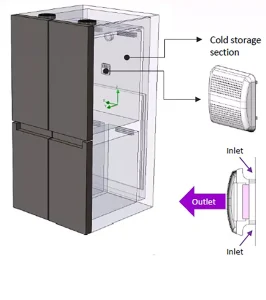 IV: Refrigerator Air Circulation
IV: Refrigerator Air Circulation
Problem: Bacteria spread from one food to another.
Goal: Disinfect the air without heating the air.
Key Design Parameters: System must not obstruct storage space, produce low amounts of heat and allow intermittent operation.
Solution: Air filter paired with UV LED array
The point
Food safety should never be taken lightly. It is imperative to remain diligent in efforts to more effectively grow and protect food. UV-C LED technology allows a new generation of disinfection systems to be used in ways previously inaccessible to UV technology. Failure to embrace these new technologies will not only hinder food safety but prevent the industry from moving forward.
References
- Center for Disease Control and Prevention. “Foodborne Illnesses and Germs.” www.cdc.gov/foodsafety/foodborne-germs.html
- World Health Organization. “Estimating the Burden of Foodborne Diseases.” www.who.int/activities/estimating-the-burden-of-foodborne-diseases
- Stop Foodborne Illness: The Voice for Safe Food. “What is Norovirus?” stopfoodborneillness.org/pathogen/norovirus/
- Gustavsson, Jenny and Christel Cederberg. “Global Food Losses and Food Waste.” www.fao.org/fileadmin/user_upload/suistainability/pdf/Global_Food_Losses_and_Food_Waste.pdf
- AQUASTAT. “Water Withdrawal.” www.fao.org/nr/water/aquastat/infographics/Withdrawal_eng.pdf
- United Nations Department of Economic and Soicalt Affairs (UNDESA). “International Decade for Action ‘Water for Life’ 2005-2015.” www.un.org/waterforlifedecade/scarcity.shtml
- Relifweb. “2017 UN World Water Development Report, Wastewater: The Untapped Resource.” reliefweb.int/report/world/2017-un-world-water-development-report-wastewater-untapped-resource
- Boston University. “Minamata Disease.” www.bu.edu/sustainability/minamata-disease/
- Food Safety News. “USDA: U.S. Foodborne Illnesses Cost More Thant $15.6 Billion Annually.” www.foodsafetynews.com/2014/10/foodborne-illnesses-cost-usa-15-6-billion-annually/
- National Geographic. “What the Disappearing Aral Sea Tells Us About the Value of Water.” blog.nationalgeographic.org/2014/10/14/what-the-disappearing-aral-sea-tells-us-about-the-value-of-water/
- Earth Observatory. “World of Change: Shrinking Aral Sea.” earthobservatory.nasa.gov/world-of-change/aral_sea.php
- Kazakhstan Travel and Tourism Blog. “The Ship Graveyard of the Aral Sea.” aboutkazakhstan.com/blog/photos/the-ship-graveyard-of-the-aral-sea/
Contact: Molly McManus, molly.mcmanus@aquisense.com; Kayla Doerzbacher, kayla.doerzbacher@aquisense.com


